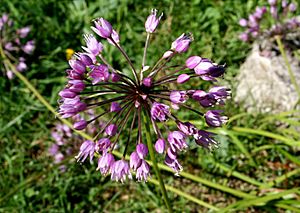Portuguese onion facts for kids
Allium lusitanicum is a type of plant often called the Portuguese onion or mountain onion. It's found across many parts of Europe, especially in areas with mountains. You can find this plant in almost every country from Portugal to Ukraine, but it's not usually found in Iceland, Ireland, the United Kingdom, Netherlands, Belgium, Luxembourg, Denmark, Finland, Albania, or Greece.
This plant grows from a bulb (like an onion) and lives for many years. It has thin, thread-like leaves that are shorter than its flower stalks. These stalks, called stipes, can grow up to 20 centimeters (about 8 inches) tall. The flowers have parts called tepals (which are like petals), anthers (which hold pollen), and styles (part of the female flower). All these parts are a beautiful uniform shade of rose-violet.
Quick facts for kids Portuguese onionor mountain onion |
|
|---|---|
 |
|
| Scientific classification | |
| Synonyms | |
|
More About Allium lusitanicum
What Does "Perennial" Mean?
When a plant is described as a "perennial," it means it lives for more than two years. Unlike annual plants that complete their life cycle in one year, or biennials that live for two years, perennials like the Portuguese onion come back year after year. They often have special parts, like bulbs, that help them survive colder seasons underground.
Where Does It Grow?
The Portuguese onion prefers to grow in mountainous regions. This means it's adapted to cooler temperatures and rocky soils often found in these areas. Its wide distribution across Europe shows how well it can adapt to different environments within these regions.
See also
- In Spanish: Allium lusitanicum para niños

